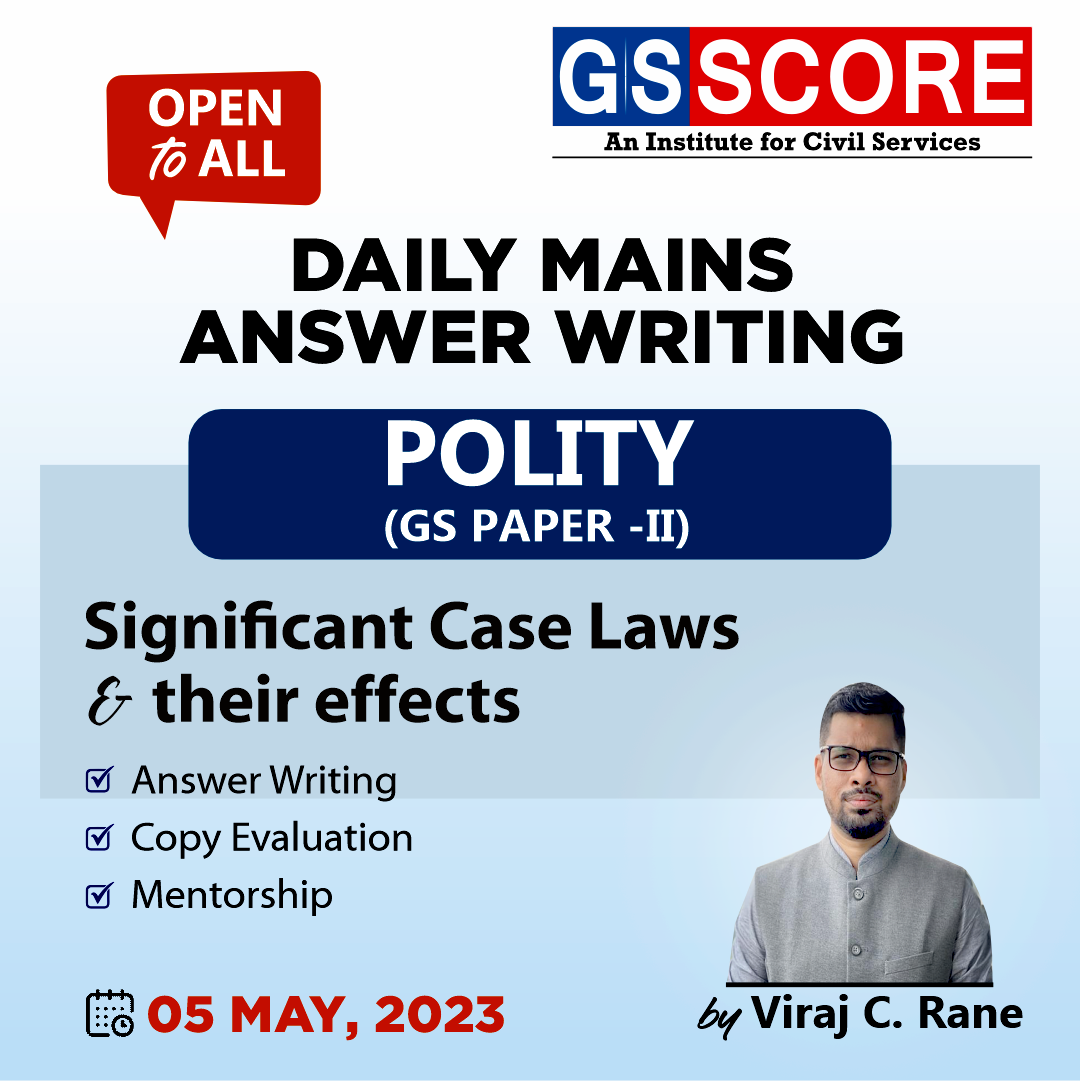


Instruction:
- There will be 2 questions carrying 10 marks each. Write your answers in 150 words
- Any page left blank in the answer-book must be crossed out clearly.
- Evaluated Copy will be re-uploaded on the same thread after 2 days of uploading the copy.
- Discussion of the question and one to one answer improvement session of evaluated copies will be conducted through Google Meet with concerned faculty. You will be informed via mail or SMS for the discussion.
Question #1. Give an account of the evolution of relationship between Fundamental Rights and DPSPs in light of some of the judgments of the Supreme Court.
Question #2. Discuss the need for Criminal justice reforms in India. Also, explain how the Supreme Court judgments have established a new legal precedent of making system reform-oriented rather than punishment-oriented.
(Examiner will pay special attention to the candidate's grasp of his/her material, its relevance to the subject chosen, and to his/ her ability to think constructively and to present his/her ideas concisely, logically and effectively).
STEPS & INSTRUCTIONS for uploading the answers
Step 1 - The Question for the day is provided below these instructions. It will be available at 7:00 AM.
Step 2 - Uploading of Answers : Write the answer in A4 Sheet leaving proper margins for comments and feedback and upload the PDF in MY ACCOUNT section. Click on the option of SUBMIT COPY to upload the PDF.
Step 3 - Deadline for Uploading Answers: The students shall upload their answers by 7:00 PM in the evening same day. The first 50 copies will be evaluated.
Step 4 - Feedback : Mentors will give their feedback for the answers uploaded. For more personalised feedback, join our telegram channel by clicking on the link https://t.me/mains_answer_writing_cse . A one-to-one session will be conducted with the faculty after copy evaluation in 72 Hrs.
Model Answer
Question #1. Give an account of the evolution of relationship between Fundamental Rights and DPSPs in light of some of the judgments of the Supreme Court.
Approach:
- Give a brief introduction about the importance of Fundamental Rights and Directive Principles of the State Policy
- Briefly discuss the evolved relationship between them.
- Conclude by discussing how they have complemented each other to balance social and individual interests.
Hints:
Supreme Court in KC Ranjeevan case 1991 held that the fundamental rights and Directive principles of the State policy together constitute the core and conscience of the Constitution. The fundamental rights are justifiable political rights and DPSP are the socio economic goals which the state must strive to attain.
Evolution of relationship between Fundamental Rights and DPSPs:
- In the Champakam Dorairajan case (1951), the Supreme Court ruled that in case of any conflict between the Fundamental Rights and the Directive Principles, the former would prevail.
- In the Golaknath case (1967), the Supreme Court ruled that the Parliament cannot take away or abridge any of the Fundamental Rights, which are ‘sacrosanct’ in nature. In other words, the Court held that the Fundamental Rights cannot be amended for the implementation of the Directive Principles.
- The Parliament reacted to the Supreme Court’s judgement in the Golaknath Case (1967) by enacting the 24th Amendment Act (1971) and the 25th Amendment Act (1971). The 24th Amendment Act declared that the Parliament has the power to abridge or take away any of the Fundamental Rights by enacting Constitutional Amendment Acts.
- The 25th Amendment Act inserted a new Article 31C which contained the following two provisions:
- No law which seeks to implement the socialistic Directive Principles specified in Article 39 (b) 22 and (c) 23 shall be void on the ground of contravention of the Fundamental Rights conferred by Article 14 (equality before law and equal protection of laws), Article 19 (protection of six rights in respect of speech, assembly, movement, etc) or Article 31 (right to property).
- No law containing a declaration for giving effect to such policy shall be questioned in any court on the ground that it does not give effect to such a policy.
- In the Kesavananda Bharati case24 (1973), the Supreme Court declared the above second provision of Article 31C as unconstitutional and invalid on the ground that judicial review is a basic feature of the Constitution and hence, cannot be taken away. However, the above first provision of Article 31C was held to be constitutional and valid.
- In the 42nd Amendment Act, it accorded primacy to DPSP over the FRs under Articles 14, 19, and 31.
- In the Minerva mills case, the SC held that the constitution is founded on the bedrock of balance between the FR and DPSP. They both are necessary for bringing social harmony. Absolute primacy to one over other will disturb the harmony of the constitution.
- In the IR Coelho case, SC reiterated that FR and DPSP don’t contradict but form a harmonious construct.
Conclusion:
In recent times, the horizon of FR has been broadened. Liberal interpretation of Articles is seen like article 21 to include rights like right to clean environment, right to live with dignity, etc. On the same lines, DPSP are being implemented. Eg., Right to livelihood under MNREGA, Right to Education, Right to Health. On the other hand, the social environment in the country is not conducive for implementation of some of the DPSP like Uniform Civil Code.
Thus, the emerging relationship between Fundamental Rights and Directive Principles of State Policy has balanced the social interest and individual interest and has further strengthened the core of the Indian constitution.
Question #2. Discuss the need for Criminal justice reforms in India. Also, explain how the Supreme Court judgments have established a new legal precedent of making system reform-oriented rather than punishment-oriented.
Approach:
- The question demands to describe the Criminal justice system of India and the urgent need to reform.
- The tone of the question is critical as you should write also about the problems in the existing system.
- Introduce the criminal justice system with some figures and explain issues with the criminal justice system and how there is a dire need of the reforms.
- Explain how the Supreme Court judgments have led to betterment of the system.
- Conclude with suggestions.
Hints:
The Criminal Justice System (CJS) encompasses a series of institutions, agencies, and processes established by the government to curb crime in the nation. The purpose of a criminal justice system is to preserve and defend the rule of law, maintenance of order, speedy trial, penalization of offenders, rehabilitation of offenders through the judicial system, and solace to victims of crimes, etc. The current criminal justice system is affected by various loopholes and faults.
The Prison Statistics brought out by the National Crime Records Bureau (NCRB) clearly demonstrates the need of reforms. According to the report, more than 66% of India’s prisoners are under trials and more than 80% of reported crimes went unpunished due to several reasons and the loopholes in the present criminal justice system.
Issues with the criminal justice system:
- Ineffectiveness: Hundreds of outdated laws such as Indian Penal Code still exist in India which highlights the colonial legacy of ICJS, making it less effective for the contemporary needs of the society. Laws such as Sedition (Section124A), and Attempt to Commit Suicide (Section309) have invited scrutiny time and again.
- Pending: With nearly 30 million criminal cases pending in the system (the annual capacity of which is only half that number), and with another 10 million or more cases being added every year, whatever is left of the system is bound to collapse completely unless some radical alternatives are adopted urgently. Speedy trial is one of the facets of the fundamental right to life and liberty enshrined in Article 21 of the Constitution of India and the law must endure reasonable, just and fair procedure which has a creative connotation
- Corruption: Transparency International found that 62% of people reported paying bribes during their interactions with the police. Misaligned incentives to arrest persons (for example, to demonstrate the progress of investigations) have resulted in 60 per cent of all arrests being “unnecessary or unjustified”.
- Inadequate infrastructure: There are also enormous shortfalls in the number of police chowkis, weapons, forensic science laboratories (FSLs) and the like. Against a UN norm of 222 police personnel per lakh of population, India’s officially sanctioned strength is a paltry 181, and the actual strength is an abysmal 137. Similarly, all the judges in the country add up to just 18 per million population, despite a three-decade-old Law Commission recommendation to increase it to 50, which itself is at the low end of the ratio in developed countries.
Role of Supreme Court judgments in criminal justice system reforms:
- In India, there have been numerous landmark judgments regarding criminal law, and each time, such judgments have not only assisted the judiciary in delivering justice to the victim but have also established a new legal precedent that shall deliver new legal principles or concepts.
- In the Rambabu Singh Thakur v. Sunil Arora (2020) case, the Supreme Court directed the political parties at the Central level and State level to upload on their respective websites the correct details concerning the pending criminal cases against the selected candidates, with the reasons why such candidate has been selected instead of other candidates with no criminal record.
- The Supreme Court of India, in the Anuradha Bhasin v. Union of India (2020) case, held that Section 144 CrPC cannot be used as a tool to prevent legitimate expression of opinion.
- The court, in the Paramvir Singh Saini v. Baljit Singh (2020) case directed all the States and Union Territories to install CCTV cameras in their jurisdictional police stations. The Apex court also directed the Central government to install CCTV cameras at the central agencies' places where interrogation of people takes place.
Conclusion:
The Criminal Justice System in India is currently in a state of uncertainty and is highly unpopular due to its inefficiency. The reforms in India’s Criminal Justice System are a need of the hour. The government needs to draft a clear policy that can inform changes in the Indian Penal Code and Code of Criminal Procedures. The reforms should not only make CJSI more efficient but also be sensitive to both the innocent and the needs of the law enforcement officers. Penal code should be modified to incorporate the present-day societal, economic, and other changes.
Proper investigation of crimes, rationalisation of court systems by inducting technology, and limiting appeal procedures to a minimum is the need of the hour. The system should be victim-centric to ensure that the victims get justice. And finally, all the important recommendations of the Malimath committee and the Prakash Singh Case judgment should be implemented.
Interpretation of the Constitution is one of the most important functions of the Supreme Court. It not only helps in clearing ambiguity over the provision of our fundamental law but also acts as a law in itself. The decisions on Supreme help in the Elaboration of answers and have gained in importance taking into consideration the demand of the questions asked by UPSC.

